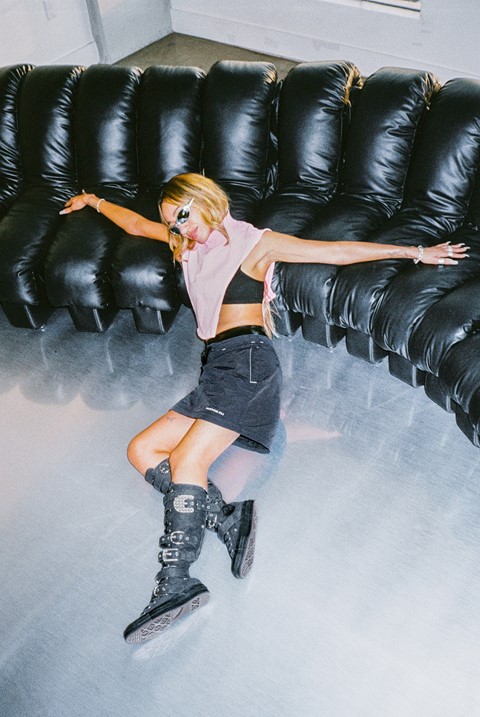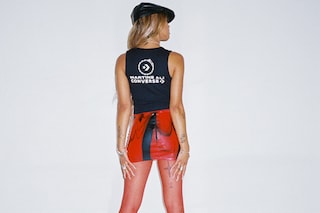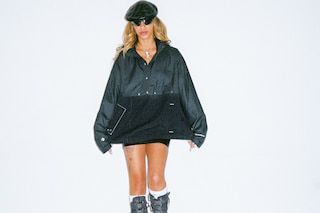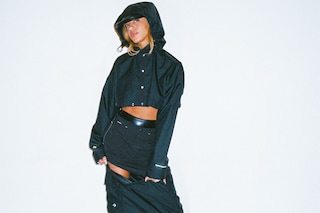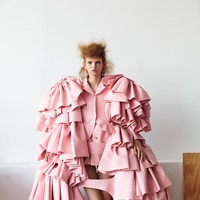Ahead of the second drop of her collab, the New York-based jewellery designer speaks on her new Chuck 70 XXHi and the process of designing the collection
As children, most people try their hand at a playful entrepreneurial hobby. For some, it was a lemonade stand or Girl Scout cookies, but for Brooklyn-based designer Martine Ali it was hand-making jewellery. “I had a babysitter that was just kind of trying to keep me busy and brought me to the bead counter. We started making bracelets and I found out that that was my thing.”
What started as a fun way to pass time quickly became a business. “My mom started wearing the pieces to work. I would go to her office, lay stuff out on the conference table and her friends would buy them,” Ali explains. “She started hosting these trunk shows for me at the house and these grown women would fight over necklaces. It was the start of something that brought income and inspired a real passion. “Over two decades on from her trunk shows, Ali has established herself as a renowned jewellery designer, with her pieces appearing on the likes of Bella Hadid, 21 Savage, Bad Bunny and Sza.
Last year, Martine merged the aesthetics of her eponymous brand and Converse to launch the Chuck 70 De Luxe Wedge, now for their second collaboration she has reinterpreted the iconic Chuck 70 to launch Chuck 70 XXHi. Available in monochrome-washed black denim, complete with matching Chuck patch, midsole, lace, and toecap, the new Chuck embraces Ali’s signature personal style. With a strong focus on versatility, the design features five press studs and four zig-zag stitched accents, inviting personalisation through the addition of chains or jewellery from her namesake line.
Accompanying the footwear launch is a range of apparel that mirrors Ali’s distinctive aesthetic, engineered for adaptability. The jacket, reminiscent of welding attire, features snap-on mechanisms for a seamless transition from cropped to full coverage. Ali also designed a skirt, crafted from utility fabrics which transform from a mini to a maxi length.
Launching today in London, alongside other creatives Rifke, Tigris and Audrey Large, Ali’s latest design will be on display at the label’s New Edge London event at 180 Studios. Elsewhere, members of the public can also celebrate the launch, Converse has organised an interactive exhibit conceptualising alternate takes on the future of style and celebrating each creative’s forms of expression.
Below Ali spoke to us about her journey into jewellery making, working on a selection collection with Converse and creating wearable art.
How long after making necklaces with your babysitter did you realise you were good at it and could pursue it as a career?
Martine Ali: Quite soon after. To be honest my mom was like, ‘No, I want to buy this from you. I want you to equate your creativity with being able to make money off of it.’ I was doing those trunk shows as a kid and making $3,000 a night, which for me was and I have my mom to thank for that.
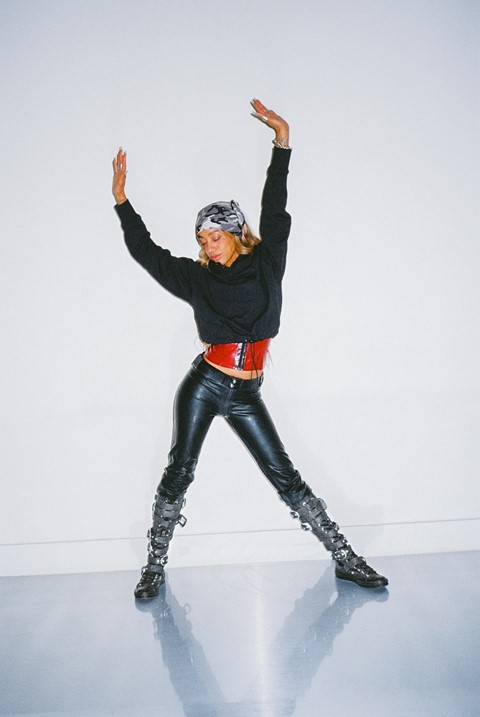
Do you remember when you officially started Martine Ali the brand?
Martine Ali: I remember there was there was a very distinct moment when I started working with chain and I think that even though that wasn’t like the first ’piece’ for my brand it definitely opened a whole new dialogue. I remember cutting up small fine pieces of chain and draping them to create these shapes and silhouettes with a lot of smaller chains. I think was the moment when the door to the core of my brand was opened for me because chain is now the material that I work most in. It’s the most signature and iconic for the brand. So I think moving away from beads or stones was a specific moment for me and that was when I was in high school.
You often reference hip-hop and grunge culture in the 90s in your pieces, who were your style icons from that era and growing up?
Martine Ali: Gwen Stefani, but there were different versions of that kind of music video girl. I think Gwen would be more on the alternative end of the spectrum but then I also was obsessed with Christina Aguilera, that’s also when Destiny’s Child and Mya came out. There were a lot of really powerful female musicians pioneering in their space and were bringing fashion into [music] videos, on TV and in paparazzi photos. It was a time when the artists were responsible for bridging that gap between fashion and the everyday person.
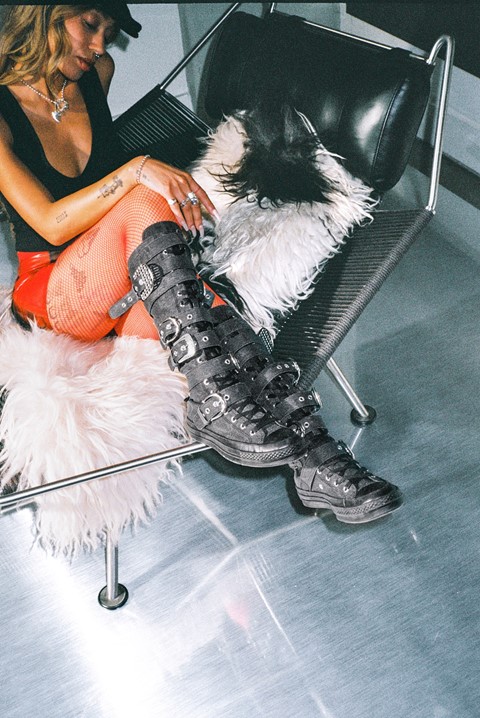
Your work often blurs the lines between fashion and art. How do you approach the creative process when designing pieces that are both wearable and artistic?
Martine Ali: I really locked into a creative practice when I was sharing a studio space with a sculptor and a painter. I think for me it’s really important to look at a three-dimensional piece that’s going to live on the body and look at it flat and to pay attention to the composition. That’s why a lot of our design details are often at the closure and at the back so that it’s a beautiful piece all the way around.
I try to look at it as if this were just something that lived on a shelf and you never wore, would it be as beautiful and as desirable? I like to play with that. There are many different levels you know of things being more wearable or things being a bit more designed and a little bit less wearable every day. I like to play in that space.
How did the collaboration with Converse first come about?
Martine Ali: I have been dabbling with shoes for a couple of years, just as another medium to play with. I feel it’s important if you’re a writer, for instance, to creatively wrap your mind around something else because I think it just really inspires a larger conversation for your work. So I was always playing with shoes, deconstructing them and putting them back together. I had an interest in designing them and I really wanted to do a sneaker heel.
I had been speaking with someone about sneakers but nothing ever really worked out, but finally I was able to speak to someone from Converse. I had a really specific concept in mind for them and I had a really specific idea I was trying to bring to reality. That’s how it started and also, being in New York, I had some six degrees of separation from some people at Converse.
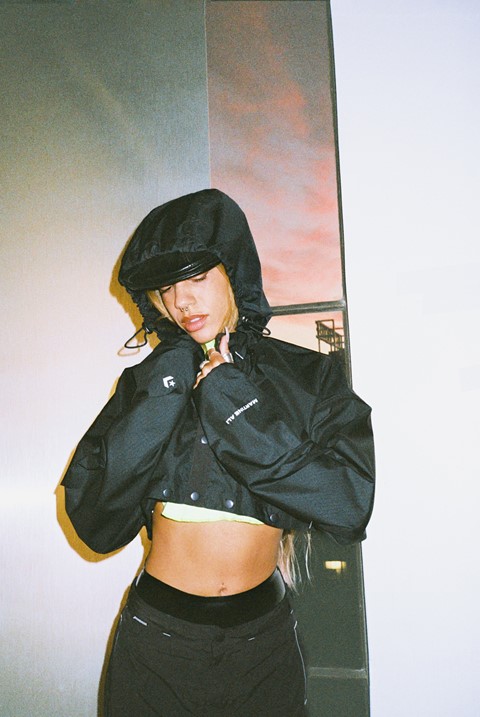
How was working on the Chuck 70 XXHi and this collection different to working on the first collaboration? Did you approach the design process any differently or learn anything from the first time which informed this collection?
Martine Ali: What was cool with the second shoe is we did more development because we had more time. So we actually took belt buckles and pieces that I was working with in jewellery and we developed them into shoe hardware. The Chuck 70 XXHi has more metal on it and it has more of a little overlap with motifs, concepts and things that I was using in the jewellery space. It was really cool to be able to push that envelope. Once the second time came around it was like really perfect to actually take jewellery pieces and say, ‘let’s take this choker you’re working with and let’s take the buckle off of that and turn it into a shoe buckle.’
Could you tell us a bit about the clothes you designed for the collaboration, what was your key inspiration for those pieces?
Martine Ali: I took a lot of inspiration from my lifestyle; I am always moving around in and it’s a studio wardrobe. It’s for those days when you’re at work and you have to go out afterwards and you want to look a little different, so everything is really convertible and flexible.
I have this piece that’s modelled and inspired by a welding jacket – which I find super interesting and very beautiful. All the things that welders wear and people who are actually working with metals and working in creative spaces like day to day, their uniforms and sense of day-to-day dress are really interesting to me. I just borrowed from that sensibility and really stepped into the idea of ‘work uniform’ and pieces I would feel really comfortable in at my studio. Something casual and then something that I can transition into other parts of my lifestyle if I want to go out afterwards or if I have to switch it up.
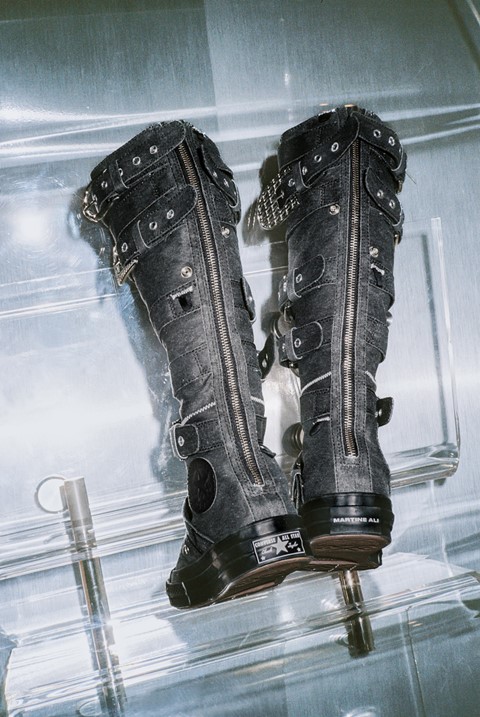
What advice would you give to aspiring jewellery designers?
Martine Ali: Look at it as an artistic practice. Devote a space or a time of day or time of the week where you are just going to sit there and work on it. I think like so much comes out of just that almost playtime to just explore. Also, removing the parameters of ‘I need to finish this’ or ‘I need to design the collection’. Use that time to move through your process and do not have any expectations, just completely play. I also think it’s really important to be creative in other parts of your life and using that creativity to inspire your hero medium.
Your pieces have been worn by many prominent figures, is there someone you would love to see in your pieces who has not worn them yet?
Martine Ali: As far as music artists and the more traditional ’celebrities’, I feel like we’re in a good space. I would like to see more people behind the scenes wearing jewellery, and more designers! I would love to make a piece for Martine Rose – for me, that’s the type of validation that means the world. I have some other fine artists wearing my jewellery and it’s really cool to see people that are completely removed from the limelight. It’s the people that are living in it and that are producing other cool beautiful things for other people – that would be really awesome at this point to feel supported almost internally.
